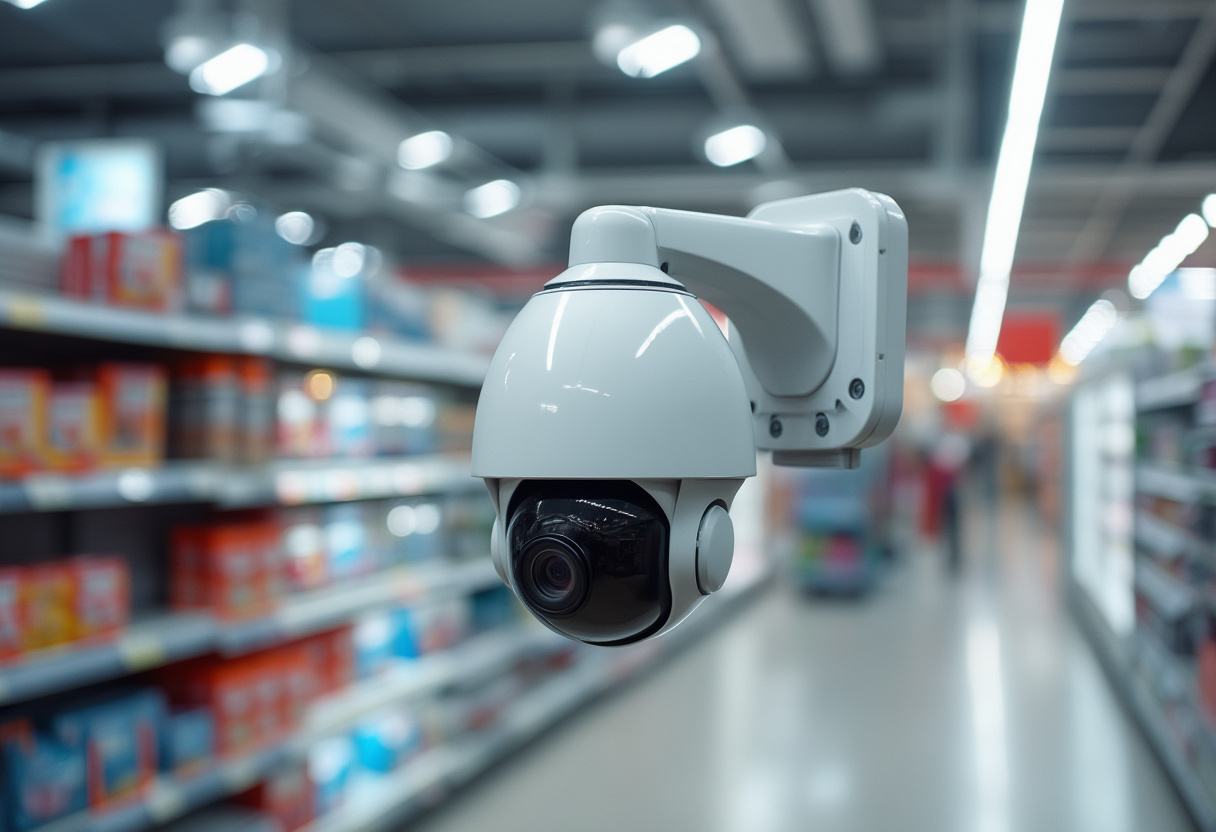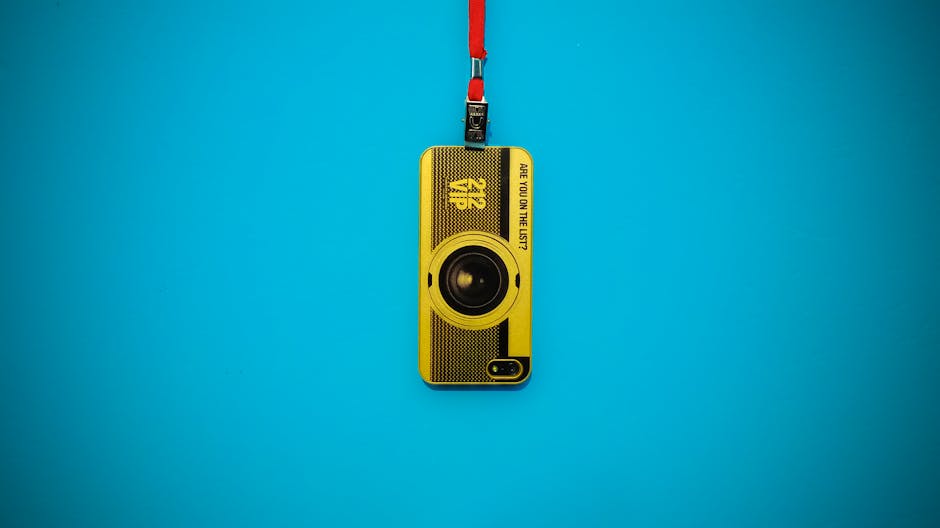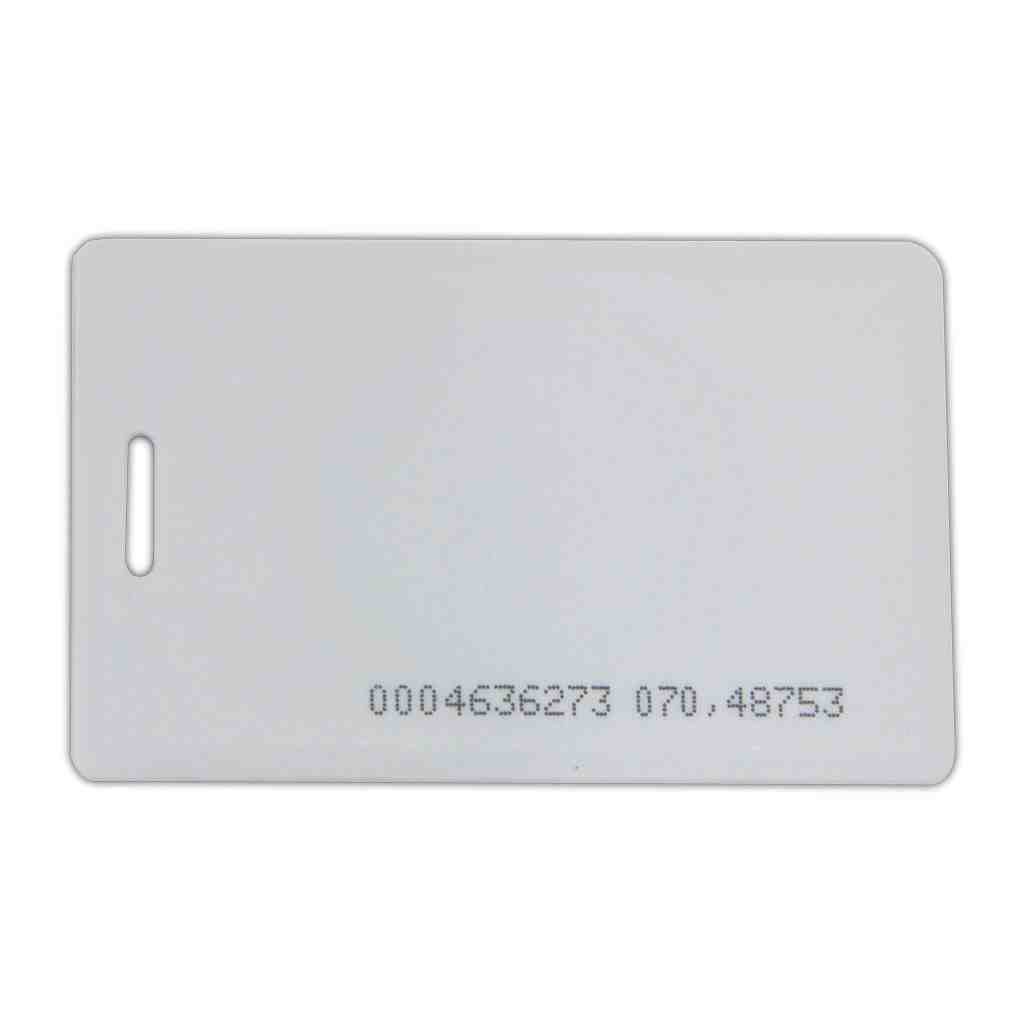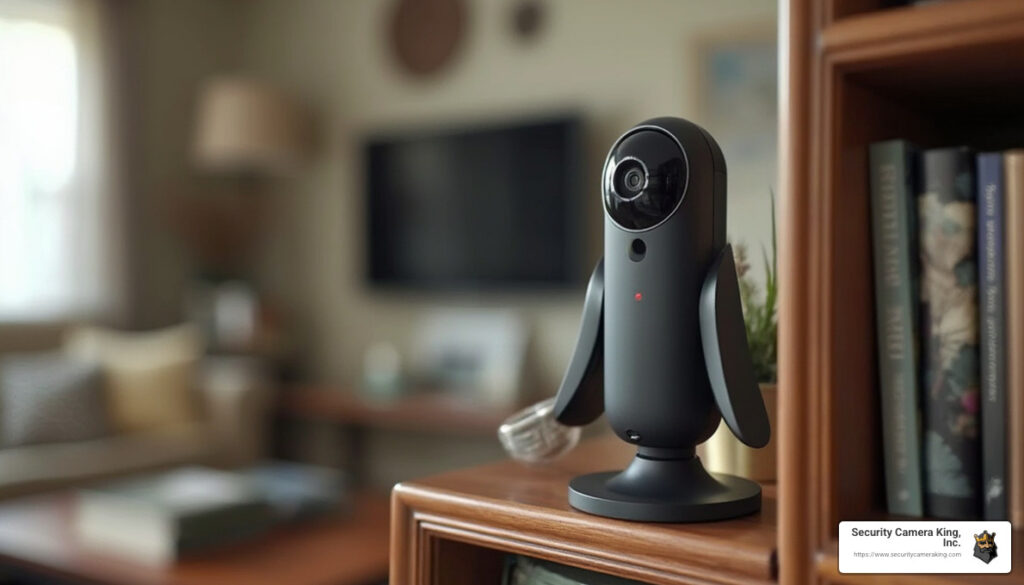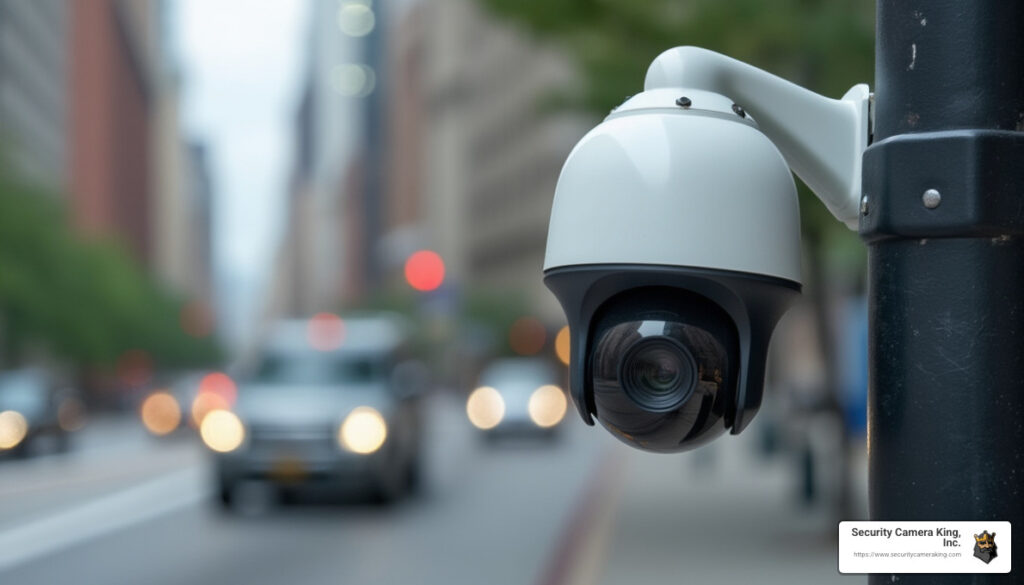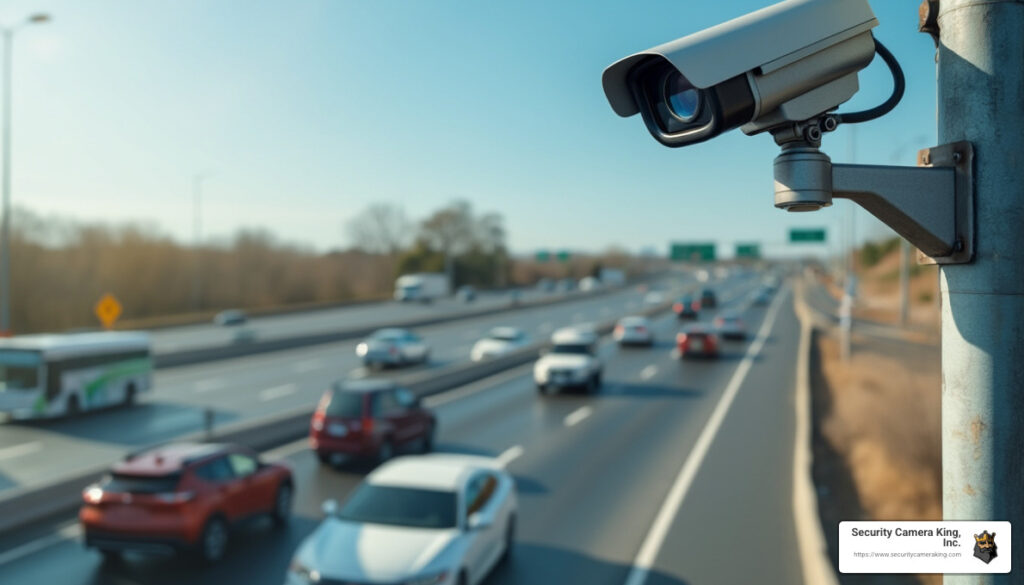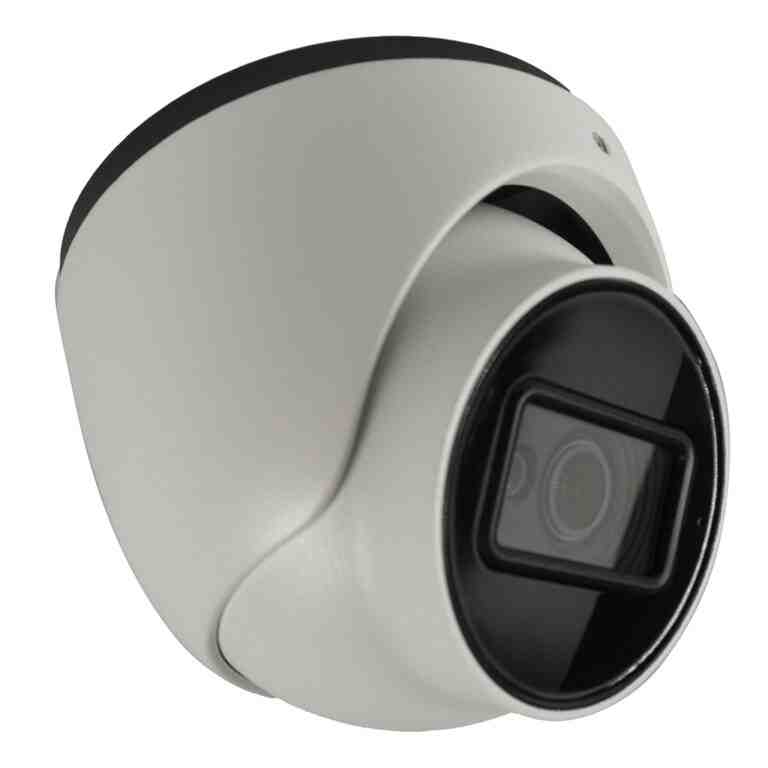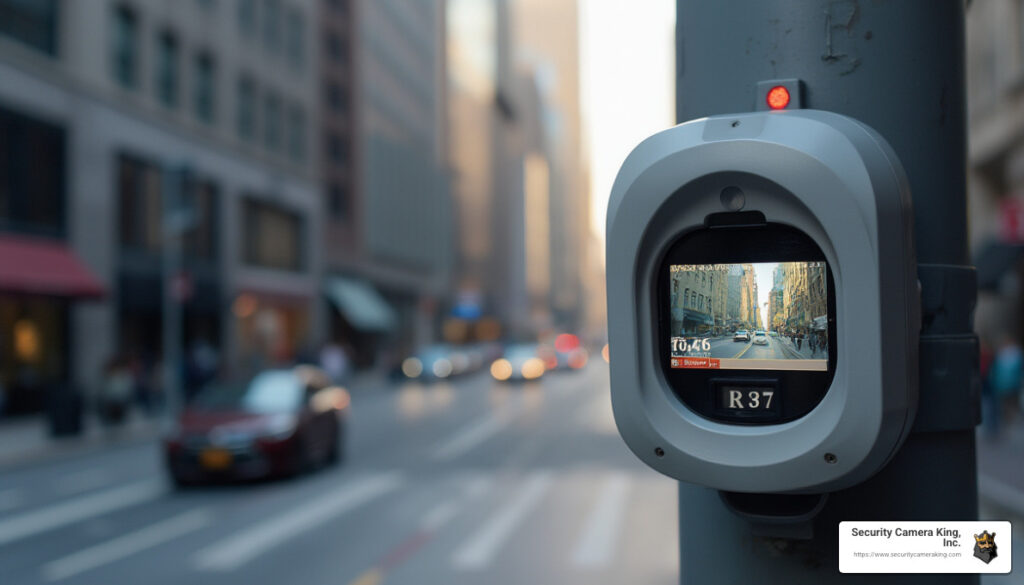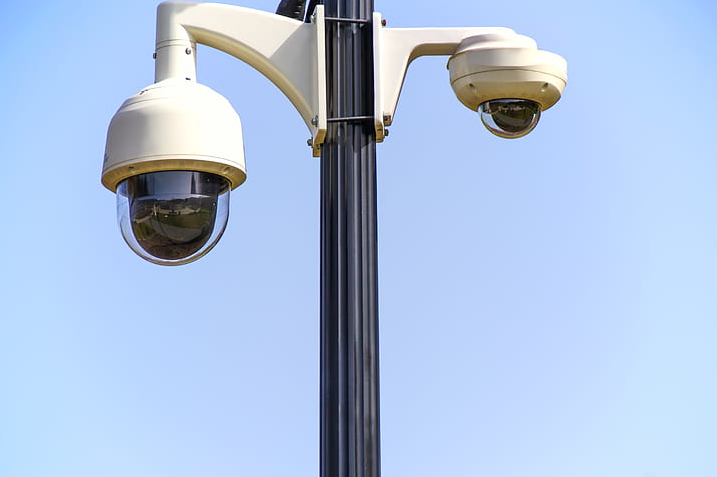Pan Tilt Zoom Cameras: Top Benefits for 2025 Security
Understanding the Power of Dynamic Surveillance
Pan tilt zoom cameras are advanced surveillance devices that combine three movement capabilities in one unit, offering superior monitoring flexibility compared to fixed cameras. These versatile security tools allow you to remotely control the camera’s direction and focus, making them ideal for retail environments where comprehensive coverage is essential.
What are PTZ Cameras?
| Feature | Description |
|---|---|
| Pan | Horizontal movement (left to right) up to 360° |
| Tilt | Vertical movement (up and down) up to 180° |
| Zoom | Optical zoom (4x-55x) that maintains image quality |
| Coverage | Can monitor large areas with a single camera |
| Control | Remote operation via smartphone, computer, or dedicated controller |
PTZ cameras offer retail managers like you a powerful solution to monitor store activities, prevent theft, and ensure employee productivity. Unlike fixed cameras, these dynamic devices can be adjusted in real-time to focus on suspicious activity or track moving subjects across your store floor.
The ability to pan, tilt, and zoom means you can install fewer cameras while maintaining comprehensive coverage of your retail space. This not only reduces equipment costs but also simplifies your surveillance system management.
I’m Brad Besner, founder and president of Security Camera King, Inc., with extensive experience helping retail businesses implement effective pan tilt zoom cameras for loss prevention and operational monitoring. Our technical support team specializes in ensuring you get the most from your PTZ camera investment, from initial setup to ongoing optimization.
What Are Pan Tilt Zoom Cameras?
Pan tilt zoom cameras (PTZ cameras) are remarkable surveillance devices that bring movement and flexibility to your security setup. Unlike traditional fixed cameras that stare at one spot forever, PTZ cameras can look around—much like a security guard who can turn their head and focus on different areas of interest.

Think of a PTZ camera as having a body that can rotate, a head that can nod up and down, and eyes that can zoom in for a closer look. This dynamic trio of movements gives you incredible versatility from a single device.
The main components that make this possible include a motorized base that rotates horizontally, a tilt mechanism for vertical movement, a zoom lens assembly that brings distant objects closer, a durable camera housing to protect everything from the elements, and a smart control circuit board that manages all operations.
Here at Security Camera King, we’ve seen how these cameras transform security operations for our customers. There’s something almost magical about watching a PTZ camera smoothly track movement across a property—all while you control it from the comfort of your office or even your smartphone.
How Do PTZ Cameras Work?
The beauty of pan tilt zoom cameras lies in their neat engineering. When you send a command (perhaps with a click on your phone or computer), the camera springs into action through a sophisticated system of motors and gears.
The pan function rotates the entire camera housing left or right—imagine being able to look from one end of your property to another without moving from your chair. Depending on the model, this rotation can cover anywhere from 180 to a full 360 degrees.
The tilt function works similarly but in the vertical plane. With another simple command, the camera tilts up to check the upper floors of a building or down to monitor activity at ground level, typically within a 180-degree range.
As for zoom, this is where things get really interesting. The camera can bring distant objects closer through optical zoom (where the lens physically moves) or digital zoom (where the image is electronically enlarged). For security purposes, optical zoom is generally preferred because it maintains image clarity even when zoomed in tight.
Many of our customers love the preset feature of modern PTZ cameras—you can save specific positions and zoom levels, then have the camera automatically move between these viewpoints with a single command. It’s like having multiple cameras in one!
The Importance of Pan, Tilt, and Zoom Functions
“PTZ cameras combine three distinct motions—pan, tilt, and zoom—in one device, which allows for versatile monitoring across large areas.” This powerful combination creates surveillance capabilities that fixed cameras simply can’t match.
The pan function gives you horizontal coverage that’s perfect for wide-open spaces. Imagine a parking lot at a shopping center—instead of installing six or seven fixed cameras along the perimeter, one strategically placed PTZ camera can scan the entire area, either following a programmed pattern or responding to your manual control.
The tilt capability handles vertical adjustments, which becomes essential when monitoring multi-level environments. A college campus with hills and stairs, a manufacturing facility with equipment at various heights, or a multi-story office building—all benefit tremendously from this up-and-down movement.
The zoom function might be the most impressive feature of all. It transforms a wide-angle view into a detailed close-up in seconds. This allows you to identify faces, read license plates, or examine suspicious packages from a safe distance. When someone asks, “Can you zoom in on that?”—you actually can!
Together, these three functions create a truly adaptable security tool. One PTZ camera can potentially replace multiple fixed cameras, saving you money while actually improving coverage. It’s like having a security guard who can move their eyes, head, and even walk closer to investigate—all without leaving their post.
For more detailed information about similar technology, you might want to check out more info about pan tilt cameras.
Optical Zoom vs Digital Zoom in PTZ Cameras
When shopping for pan tilt zoom cameras, you’ll often see impressive zoom numbers in product descriptions. But not all zoom is created equal! Understanding the difference between optical and digital zoom can save you from disappointment and help you choose a camera that truly meets your security needs.

Think of optical zoom as a pair of binoculars – it physically adjusts the lens to bring distant objects closer while maintaining clarity. Digital zoom, on the other hand, is more like taking a picture and cropping it – you’re essentially just enlarging pixels, which reduces quality.
| Feature | Optical Zoom | Digital Zoom |
|---|---|---|
| Mechanism | Physical lens adjustment | Software enlargement |
| Image Quality | Maintains original quality | Reduces quality as zoom increases |
| Detail Preservation | Preserves fine details | Details become pixelated |
| Zoom Range | Typically 4x to 55x | Unlimited (but with quality loss) |
| Live Monitoring | Ideal for real-time surveillance | Limited usefulness at high magnifications |
| Storage Impact | No additional storage required | No additional storage required |
| Cost Impact | More expensive to implement | Less expensive to implement |
What is Optical Zoom?
Optical zoom is the real star of the show in pan tilt zoom cameras. When you use optical zoom, the camera physically moves its internal lens elements to magnify the image – just like a telescope brings distant planets into view.
The beauty of optical zoom is that your camera captures the magnified image directly. This means whether you’re zoomed all the way out or zoomed in tight on a license plate 100 feet away, you’re getting the full resolution your camera is capable of. The pixel density stays consistent, so details remain crisp and clear.
This is why we at Security Camera King always emphasize optical zoom capabilities in our professional security cameras. When you need to identify a face or read text from a distance, nothing beats the clarity of true optical zoom. It’s especially crucial for live monitoring situations where you need actionable details in real-time.
Understanding Digital Zoom
Digital zoom is essentially a shortcut – instead of using specialized optics, the camera simply crops the center portion of the image and enlarges it through software. It’s similar to taking a photo on your phone, then pinching to zoom in after you’ve taken it.
While this approach is certainly less expensive to implement (no fancy moving lens elements required), it comes with a significant downside: quality degradation. As you increase digital zoom, you’re stretching the same number of pixels to cover a larger area, resulting in that blocky, pixelated look we’ve all seen in poor-quality security footage.
Digital zoom isn’t all bad – it can be useful for quick adjustments when reviewing recorded footage or for slight magnification. Many of our pan tilt zoom cameras include some digital zoom capability as a supplement to their optical zoom. Just be wary of marketing that combines both types into one impressive-sounding number without clarifying the distinction.
Why Optical Zoom Matters for Pan Tilt Zoom Cameras
In the security world, image clarity isn’t just about aesthetics – it can make or break your ability to identify suspects or understand what’s happening in a critical situation. This is where optical zoom truly shines.
With proper optical zoom, your security team can spot suspicious activity from across a parking lot, zoom in to verify what’s happening, and even identify individuals involved – all without losing image quality. This operational flexibility means you can effectively monitor large areas with fewer cameras, potentially saving on overall system costs.
According to research from the University of Adelaide on real-time target tracking with PTZ cameras, “The quality of the zoom capabilities directly impacts the system’s ability to maintain target identification during tracking operations.” Scientific research on image quality in zoom confirms what we’ve seen in practical applications for years.
For businesses serious about security, investing in quality optical zoom isn’t just a technical preference – it’s essential for capturing usable evidence that can stand up to scrutiny if needed in legal proceedings. That’s why at Security Camera King, we prioritize robust optical zoom capabilities in our pan tilt zoom cameras, ensuring you can see what matters, when it matters most.
Advantages of Using PTZ Cameras for Security
When it comes to keeping an eye on things, pan tilt zoom cameras are like having your very own security superstar on duty. Unlike their fixed-camera cousins that stare at the same spot all day, PTZ cameras can swivel, tilt, and zoom in on the action wherever it happens.

Improved Surveillance with Pan, Tilt, and Zoom
Think about it this way: instead of installing five or six fixed cameras to watch your property, you might only need one or two well-placed pan tilt zoom cameras. This means you’ll spend less money upfront on equipment and installation. Your wallet will thank you!
Beyond just saving you some cash, fewer cameras also means less maintenance headaches down the road. There’s something satisfying about checking one device instead of six when it’s time for routine upkeep.
Many of our customers in Boca Raton and beyond appreciate how PTZ cameras blend into their surroundings better than a wall of fixed cameras. In places where appearance matters—like upscale retail or historic buildings—this subtle approach to security makes a big difference.
The real magic happens when something catches your attention. Let’s say you notice someone lingering a bit too long near your loading dock. With a fixed camera, you’d just have to hope they stay in frame. With a pan tilt zoom camera, you can immediately swivel toward them, tilt to get the perfect angle, and zoom in to see exactly what they’re up to. That kind of flexibility is priceless when seconds count.
Auto-Tracking and Motion Detection
Here’s where today’s pan tilt zoom cameras really shine. Modern PTZ cameras don’t just sit there waiting for you to control them—they actively participate in your security efforts with some pretty impressive smarts.
Auto-tracking technology is like having a dedicated security guard who never gets distracted or tired. Once the camera spots something moving, it can follow that person or vehicle automatically, keeping them in frame without any human intervention. This is especially helpful if you can’t be glued to your security monitors 24/7 (and who can?).
According to research from the University of Adelaide, these tracking systems use sophisticated algorithms to “maintain persistent surveillance of moving targets.” In plain English, that means the camera does the work of following suspicious activity while you focus on deciding how to respond.
The motion detection capabilities in today’s PTZ cameras go well beyond the basic “something moved!” alerts of yesterday. Modern systems can tell the difference between a person walking across your parking lot and a plastic bag blowing in the wind. They can pay special attention to certain areas within their view while ignoring others. Some can even recognize behaviors that typically spell trouble, like someone pacing back and forth too long or moving erratically.
What’s particularly clever is how these cameras can anticipate where they might be needed. If motion is detected at the edge of one camera’s view, another pan tilt zoom camera can automatically swing over to that area before you even realize there might be a problem. It’s like having eyes in the back of your head—if your head could also swivel 360 degrees!
At Security Camera King, we’ve seen countless customers amazed at how these smart features transform their security from passive recording to active protection. Whether you’re watching over a small shop or a sprawling warehouse, the dynamic capabilities of PTZ cameras provide peace of mind that fixed cameras simply can’t match.
Key Features to Consider When Purchasing a PTZ Camera
Shopping for a pan tilt zoom camera can feel overwhelming with all the technical specifications and features to consider. I’ve helped hundreds of customers find the perfect camera for their needs, and I’ve found that focusing on these key features will guide you to the right choice without the headache.
Optical Zoom Range and Resolution
Let’s talk about zoom first – it’s right there in the name after all! The optical zoom capability is what lets you see those important details from a distance.
Think about your space when choosing zoom levels. If you’re monitoring a large parking lot or warehouse, you’ll want a camera with at least 20x-30x zoom capability. While some cameras boast impressive 55x zoom, most of our customers find they rarely use beyond 25x-30x in real-world situations.
Higher zoom typically means a narrower field of view at wide angles. It’s always helpful to see for yourself – we can provide sample images at various zoom levels so you can assess the quality before purchasing.
Resolution works hand-in-hand with zoom for overall image quality. Most pan tilt zoom cameras today offer:
2MP (1080p) resolution for general surveillance needs
4MP for improved detail recognition (perfect for most businesses)
8MP (4K) for maximum detail when identification is absolutely critical
Our Elite 4MP AI 25x Zoom IR Starlight PTZ camera hits that sweet spot with 4MP resolution and 25x optical zoom. It delivers exceptional detail at a distance while keeping file sizes manageable for your recording system.
Low-Light and Night Vision Capabilities
Security doesn’t stop when the sun goes down! In fact, many incidents happen in challenging lighting conditions, making low-light performance crucial for pan tilt zoom cameras.

Modern PTZ cameras use several technologies to see in the dark. Starlight technology uses advanced sensors to capture color images in extremely low light. IR illumination provides invisible light for night vision, with typical ranges from 100-300 feet. Smart IR adjusts intensity automatically to prevent overexposure of nearby subjects.
True WDR (Wide Dynamic Range) is another feature worth looking for – it balances bright and dark areas in the same scene, perfect for entrances where bright sunlight might be streaming in behind a visitor.
Our 12x Elite Starlight 2MP Outdoor Wall Mount IP PTZ Security Camera with True WDR demonstrates these capabilities beautifully. With starlight sensor technology and 120dB true WDR, it delivers clear footage in nearly any lighting situation – from bright backlight to near-total darkness.
When checking low-light specs, look at the minimum illumination rating (measured in lux – lower numbers are better). Also consider whether you need color night vision or if black and white will suffice, and whether the camera includes an IR cut filter for better daytime color accuracy.
Connectivity and Integration
Today’s pan tilt zoom cameras need to play nice with your existing systems. Modern connectivity options include IP network connections for remote viewing, PoE (Power over Ethernet) that simplifies installation with a single cable, and wireless capabilities for those tricky spots where running cables isn’t practical.
Look for ONVIF compliance to ensure your camera works with third-party video management systems. If you’re tech-savvy, check if the camera offers API access for custom integration with other security or business systems.
Other integration features to consider include mobile app support for viewing from your smartphone, compatibility with your preferred video management software, and connections to broader automation systems. Some of our newest pan tilt zoom cameras even offer voice assistant control through platforms like Alexa or Google Assistant.
At Security Camera King, we believe in future-proofing your investment. That’s why our cameras support industry-standard protocols and offer flexible integration paths that will grow with your security needs.
Build Quality and Durability
Since pan tilt zoom cameras have moving parts, build quality directly impacts long-term reliability. Nobody wants to climb a ladder every few months to replace a failed camera!
For outdoor installations, check the IP rating – this indicates protection against dust and water. We recommend IP66 or higher for outdoor use in Florida’s challenging weather. Also look at the operating temperature range to ensure functionality in your climate.
Housing material matters too. Options include aluminum, polycarbonate, or stainless steel, each offering different levels of durability and corrosion resistance. This is particularly important for coastal installations exposed to salt air.
The quality of the pan/tilt mechanisms themselves is crucial – these are the parts that will be moving constantly. Professional-grade pan tilt zoom cameras use precision motors and gears designed for years of continuous operation.
Our outdoor PTZ cameras are engineered specifically to withstand Florida’s environmental challenges, from hurricane-force winds to intense UV exposure and sudden downpours. We’ve even had customers report our cameras continuing to function after taking direct lightning strikes (though we don’t recommend testing this feature intentionally!).
Choosing the right PTZ camera means balancing these features against your specific needs and budget. Our team at Security Camera King is always happy to help you steer these options to find the perfect fit for your security requirements.
Price Range and Factors Influencing Cost of PTZ Cameras
Shopping for pan tilt zoom cameras can feel a bit like buying a car – there’s a wide range of prices and features, and what you pay directly impacts what you get. Let’s break down what you can expect at different price points and why some cameras cost significantly more than others.

Entry-Level vs Professional PTZ Cameras
When browsing pan tilt zoom cameras, you’ll notice they generally fall into three distinct categories:
The entry-level models ($100-$300) are like the compact cars of the security world – they’ll get you from point A to B, but without many bells and whistles. These cameras typically offer modest 3x-4x optical zoom and 1080p resolution. They’re perfectly fine for monitoring a small shop or home office, but their limited precision and primarily indoor-only designs make them less suitable for demanding environments.
Mid-range options ($300-$800) represent the sweet spot for many of our customers. Think of these as the reliable sedans of security cameras – dependable performers with some nice extras. With optical zoom ranging from 12x to 20x and resolutions up to 4MP, these cameras deliver solid performance for most business applications. They’re typically weatherproof for outdoor installation and include features like basic auto-tracking that help you monitor larger areas effectively.
Professional PTZ cameras ($800-$3,000+) are the luxury vehicles of surveillance – precision-engineered with premium components and advanced capabilities. These high-end systems offer impressive optical zoom (25x to 55x), crystal-clear 4K resolution, and sophisticated AI features like intelligent tracking. They’re built to withstand extreme weather conditions and provide years of reliable service even in the harshest environments.
Here at Security Camera King, we’ve found that most businesses do best with mid-range to professional models. While they require a larger initial investment, the improved reliability and performance typically pay dividends through better security outcomes and longer service life.
Factors Affecting PTZ Camera Costs
The price tag on a pan tilt zoom camera isn’t arbitrary – several specific features drive the cost up or down. Understanding these factors helps you make smarter purchasing decisions.
Optical zoom range is perhaps the most significant price driver. Those impressive 30x or 55x zoom lenses cost substantially more to manufacture than basic 4x versions. The precision glass elements and complex lens assemblies in high-zoom cameras represent a major portion of the production cost.
Image sensor quality dramatically affects both price and performance. Better sensors with larger pixel sizes capture more light, delivering clearer images in challenging conditions. The difference between a standard sensor and a premium starlight sensor can mean the difference between a usable nighttime image and a murky blob – but that improved performance comes with a higher price tag.
Resolution is straightforward – higher resolution cameras cost more. While 1080p might be sufficient for general surveillance, 4K cameras provide the detail necessary to capture license plates or facial features from a distance. That extra detail requires more sophisticated processing hardware, driving up the price.
Smart features like AI-powered tracking add significant value but also increase cost. The advanced processors needed to run these intelligent functions represent a substantial component of premium camera pricing. When a camera can automatically follow a person across your property without human intervention, you’re paying for sophisticated software as much as hardware.
Build quality varies enormously across price points. Professional pan tilt zoom cameras use precision motors, sealed enclosures, and high-grade materials that withstand years of continuous operation in challenging environments. These quality components cost more upfront but typically deliver better long-term value through extended service life and reduced maintenance.
Brand reputation influences pricing too. Established manufacturers with proven track records often charge more, but they typically back their products with better warranties and support. At Security Camera King, we’ve carefully selected our product lineup to offer reliable performance regardless of price point.
When budgeting for your PTZ camera system, remember to consider the total investment beyond just the hardware. Professional installation might add 20-50% to your initial costs. Infrastructure requirements like network upgrades, mounting hardware, and cabling can also impact your bottom line. And don’t forget ongoing expenses for maintenance and potential subscription services for advanced features.
We’ve helped countless customers steer these considerations to find the perfect balance between performance and budget. Our team takes pride in recommending solutions that provide genuine value rather than just pushing the most expensive option. After all, the best security camera is the one that meets your specific needs while respecting your budget constraints.
Maximizing Security with Pan Tilt Zoom Cameras
Getting the most out of your pan tilt zoom cameras isn’t just about buying the right equipment—it’s about thoughtful installation and smart integration with your existing security system. After helping hundreds of businesses optimize their surveillance setups, I’ve seen how proper placement and setup can make all the difference.
Installation Considerations
Finding the perfect spot for your PTZ camera is a bit like real estate—it’s all about location, location, location!
When mounting your camera, you’ve got several options to consider. Ceiling mounts work beautifully in indoor spaces like retail stores, giving you that full 360° coverage that lets you see everything happening on your sales floor. For exterior walls, a wall mount offers excellent visibility while keeping your camera somewhat protected from the elements (which is especially important in our rainy Florida climate).
If you’re monitoring a parking lot or large outdoor area, pole mounts are often your best bet. They provide an liftd vantage point that maximizes your camera’s range. And don’t overlook corner mounts for those tricky intersecting hallways or tight spaces—they can help eliminate blind spots that might otherwise hide potential security threats.
The indoor versus outdoor decision affects more than just weatherproofing. Indoor cameras can be more discreet and aesthetically pleasing, which matters in customer-facing areas. For outdoor installations here in Florida, you’ll want to consider our unique weather challenges—hurricane-force winds, intense heat, afternoon thunderstorms, and even salt air if you’re near the coast. That’s why we typically recommend cameras with at least IP66 ratings for outdoor use.
When it comes to positioning, height matters tremendously. I usually recommend installing pan tilt zoom cameras between 10-20 feet above ground level—high enough to prevent tampering but low enough to capture identifiable details. Also, try to avoid positioning cameras directly facing bright light sources like the afternoon sun, which can create backlight issues and wash out your footage.
Power and wiring considerations shouldn’t be an afterthought. PoE (Power over Ethernet) technology has been a game-changer for security camera installation, allowing you to run just one cable for both power and data. If you’re going beyond the standard 328-foot Ethernet limit, you’ll need to plan for signal boosters or consider fiber optic solutions for longer runs.
Integrating PTZ Cameras into Security Systems
A pan tilt zoom camera is powerful on its own, but it becomes truly transformative when properly integrated into your broader security ecosystem.
Most businesses today use either an NVR (Network Video Recorder) or VMS (Video Management System) to manage their camera footage. When setting up your PTZ cameras, take time to configure recording parameters thoughtfully. Do you want continuous recording, or would motion-triggered recording better suit your needs and storage capacity? These decisions affect not just security effectiveness but also how long you can retain footage.
Software integration is where the magic really happens with modern pan tilt zoom cameras. Today’s video management platforms offer impressive control features that let you program preset positions, automated patrol routes, and even trigger responses based on detected events. Our customers love being able to set up their cameras to automatically zoom in when motion is detected in a specific area, like near a cash register or storage room door.
Remote monitoring capabilities have transformed how businesses handle security. With properly configured pan tilt zoom cameras, you can check in on your property from anywhere using your smartphone or laptop. I’ve had customers call me excitedly after they were able to zoom in on suspicious activity from their phone while on vacation—that’s the power of modern PTZ technology!
Our Elite 4MP AI 4x Zoom Mini IR Starlight PTZ w/ Built-in Mic showcases how far integration capabilities have come. With its built-in microphone, you get both visual and audio monitoring in one compact device. Its AI-powered tracking can follow subjects automatically, and network connectivity lets you access everything remotely. It’s a perfect example of how modern pan tilt zoom cameras can serve as complete security nodes rather than just isolated cameras.
Don’t forget about ongoing maintenance to keep your system running optimally. Regular testing of mechanical functions, keeping firmware updated, and cleaning camera housings and lenses are simple steps that dramatically extend the life of your investment. I recommend setting calendar reminders for these maintenance tasks—they’re easy to overlook but crucial for long-term performance.
Here at Security Camera King, our technical support team takes pride in helping customers throughout Boca Raton and across the country get the absolute most from their pan tilt zoom cameras. Whether you’re installing a new system or optimizing an existing one, we’re just a phone call away with practical advice based on real-world experience. After all, the best camera in the world won’t help if it’s pointing in the wrong direction!
For more comprehensive information about maximizing your security with PTZ cameras, check out our dedicated PTZ camera page.
Frequently Asked Questions about Pan Tilt Zoom Cameras
How do PTZ cameras perform in different lighting conditions?
Lighting conditions can make or break your surveillance system. That’s why we’ve put so much thought into how our pan tilt zoom cameras handle everything from bright sunlight to pitch darkness.
The secret sauce in today’s premium PTZ cameras is starlight technology. These remarkable sensors can capture color images in lighting as dim as 0.001 lux – that’s basically like trying to see by starlight alone! I’ve installed these cameras for clients who were absolutely stunned by the vivid color footage captured in what looked like near-darkness to the naked eye.
True Wide Dynamic Range (WDR) is another game-changer, especially if you’re monitoring areas with tricky lighting. Think about a store entrance where bright sunlight streams in while the interior remains relatively dark. Without WDR, you’d either see silhouettes or a washed-out glare. Good PTZ cameras with 120dB or higher WDR balance these extremes beautifully, giving you usable footage regardless of lighting challenges.
For complete darkness, most professional pan tilt zoom cameras include built-in infrared LEDs. These provide invisible illumination that matches the camera’s zoom capabilities. I always smile when clients see their first night vision footage – there’s something magical about watching crystal-clear video recorded in what appears to be total darkness.
The really sophisticated models take this a step further with Smart IR technology. This automatically adjusts the intensity of infrared light based on how far you’ve zoomed in and how close subjects are to the camera. It prevents that annoying “white-out” effect when someone walks too close to the camera at night while maintaining visibility in the background.
In our Florida sunshine, these features aren’t just nice-to-haves – they’re essential for consistent surveillance quality from bright midday to moonless nights.
Can PTZ cameras integrate with smart home systems and voice assistants?
The days of isolated security systems are behind us. Today’s pan tilt zoom cameras can play nicely with your existing smart home ecosystem, though capabilities vary significantly between models.
Many of our customers are pleasantly surprised to learn they can integrate their security cameras with platforms like Google Home, Amazon Alexa, Apple HomeKit, and Samsung SmartThings. This integration creates some really convenient possibilities – imagine your PTZ camera automatically swiveling to focus on your front door when someone rings the doorbell.
Voice control has become particularly popular. There’s something undeniably futuristic about saying “Alexa, show me the backyard camera” and having your feed instantly appear on your Echo Show or Fire TV. More advanced integrations even allow commands like “Hey Google, pan the driveway camera left” or “Siri, zoom in on the front gate.”
The mobile apps that come with modern pan tilt zoom cameras have gotten remarkably good too. Most offer intuitive touch controls that make adjusting your camera’s position as simple as swiping on your phone screen. You can save preset positions, receive alert notifications, and even engage in two-way conversations if your camera has audio capabilities.
When planning your smart home integration, consider a few practical factors. First, check for protocol compatibility – terms like ONVIF and RTSP indicate broader compatibility with other systems. Also think about network security, bandwidth requirements (streaming video can use significant data), and whether you prefer local processing or cloud-based solutions.
At our Boca Raton headquarters, we’ve helped countless customers create seamless integrations between their PTZ cameras and existing smart home setups. The right configuration can transform disconnected devices into a cohesive, responsive security ecosystem.
How far can a PTZ camera see?
This is probably the question I hear most often, and the answer always begins with “it depends.” The effective range of pan tilt zoom cameras is determined by several key factors working together.
Optical zoom capability is the primary factor. Think of optical zoom as your camera’s binocular power:
– 4x-10x zoom works well for shorter distances, giving you good detail up to about 100 feet
– 12x-20x zoom extends your effective range to 100-300 feet
– 25x-30x zoom lets you monitor 300-500 feet with good detail
– 40x-55x zoom is for specialized long-range applications, effective beyond 500 feet
Resolution works hand-in-hand with zoom. A 4MP camera will show you significantly more detail at distance than a 2MP model with the same zoom level. For critical identification needs, 8MP (4K) cameras provide maximum detail, though they require more bandwidth and storage.
In the security industry, we use something called DORI standards to measure effective range. DORI stands for Detection, Observation, Recognition, and Identification – the four levels of detail you might need:
- Detection: You can tell something’s there (Is that a person in the parking lot?)
- Observation: You can see movement and basic characteristics (The person is walking toward the building)
- Recognition: You can determine if you know the person (That looks like our delivery driver)
- Identification: You can positively identify someone (That’s definitely John from accounting)
To put this in perspective, a quality 30x optical zoom PTZ camera with 4MP resolution might let you detect movement at 2,000+ feet, observe behavior at 800+ feet, recognize familiar figures at 400+ feet, and positively identify people at 200+ feet.
Real-world conditions matter too. Fog, rain, heat haze, and even air pollution can reduce visibility. Mounting stability is crucial – a camera on a pole that sways in the wind won’t deliver its full potential range. And don’t forget that good lighting dramatically impacts how far your camera can effectively see.
I’ve installed pan tilt zoom cameras throughout Florida that have amazed clients with their range capabilities. There’s nothing quite like zooming in on activity a quarter-mile away with remarkable clarity – it truly feels like having a superpower!
Conclusion
Pan tilt zoom cameras represent a powerful and flexible solution for modern security challenges. Their ability to dynamically adjust viewing angles and magnification provides significant advantages over fixed cameras in many applications.
As we’ve explored throughout this guide, PTZ cameras offer remarkable versatility that can transform your security setup. A single well-placed camera can monitor expansive areas through programmable patrol patterns and preset positions, giving you comprehensive coverage without installing multiple fixed cameras. This not only saves on equipment costs but also simplifies your entire security infrastructure.
When security incidents occur, the optical zoom capabilities of these cameras truly shine. You can instantly zoom in to inspect suspicious activities or identify individuals with clarity that fixed cameras simply can’t match. This functionality proves invaluable when you need to quickly assess potential threats or gather evidence.
The intelligence built into modern pan tilt zoom cameras takes surveillance to the next level. Features like auto-tracking and motion detection work together to create a more proactive security system. Rather than passively recording, these cameras actively monitor your property, following subjects of interest and alerting you to unusual activity.
Perhaps most importantly, PTZ cameras give your security team the ability to adapt in real-time. When situations evolve, security personnel can remotely reposition cameras to follow the action, ensuring you never miss critical details during an incident.
When selecting pan tilt zoom cameras for your security system, remember to prioritize what truly matters: optical zoom quality over digital zoom, appropriate low-light performance for your environment, build quality that matches your installation conditions, connectivity options that integrate seamlessly with existing systems, and smart features that improve monitoring capabilities.
At Security Camera King, Inc., we’re committed to helping you steer these considerations to find the perfect PTZ solution for your specific security needs. Our technical support team stands ready to assist you from initial selection through installation and beyond, providing industry-leading guidance every step of the way.
Whether you’re securing a busy retail store, monitoring a sprawling warehouse, or protecting a corporate campus, pan tilt zoom cameras offer the versatility and performance to significantly strengthen your security posture. Our comprehensive range of PTZ cameras includes options for every application and budget, backed by our unwavering commitment to your satisfaction.
For personalized recommendations or to discuss your specific security challenges, reach out to our team at Security Camera King, Inc. We’d be delighted to become your partner in creating effective, reliable security solutions that provide genuine peace of mind and tangible protection for what matters most to you.

